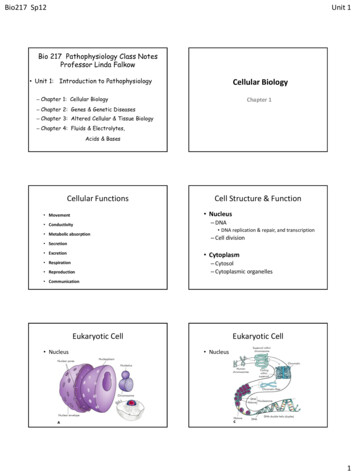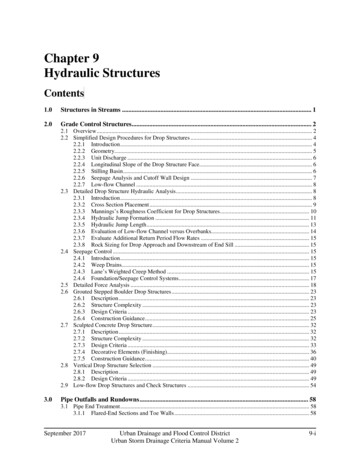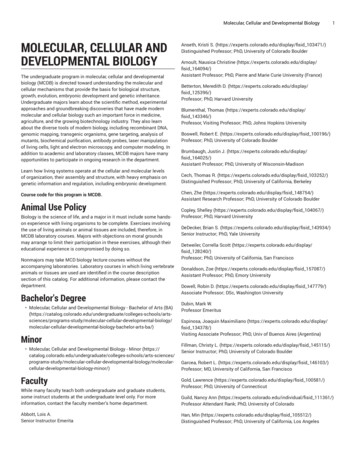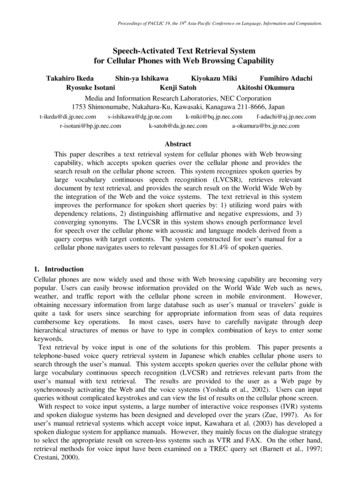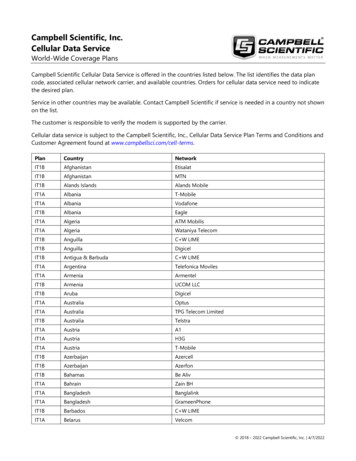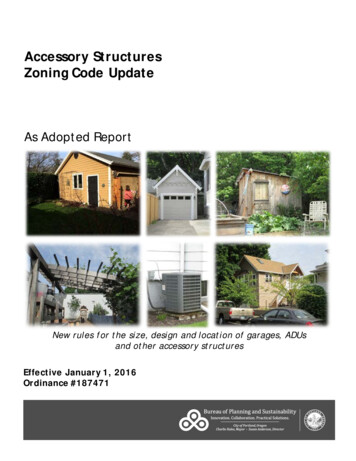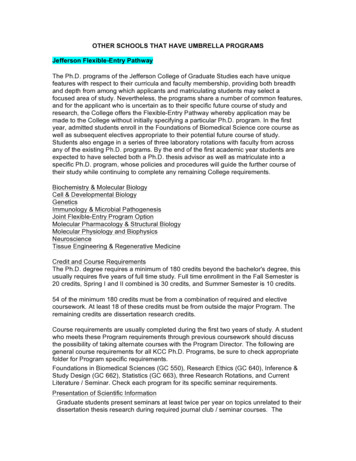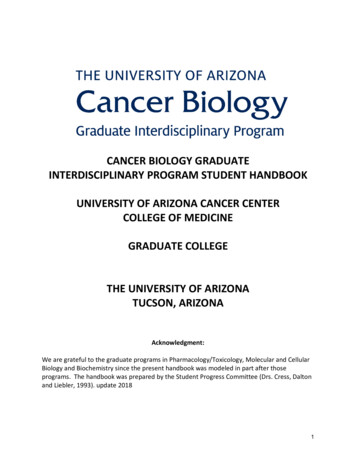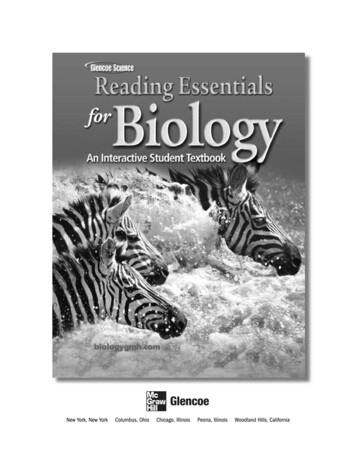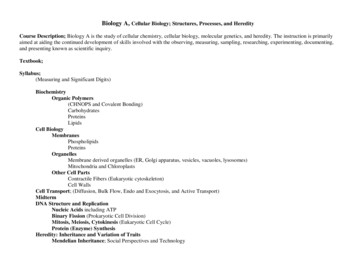
Transcription
Biology A, Cellular Biology; Structures, Processes, and HeredityCourse Description; Biology A is the study of cellular chemistry, cellular biology, molecular genetics, and heredity. The instruction is primarilyaimed at aiding the continued development of skills involved with the observing, measuring, sampling, researching, experimenting, documenting,and presenting known as scientific inquiry.Textbook;Syllabus;(Measuring and Significant Digits)BiochemistryOrganic Polymers(CHNOPS and Covalent Bonding)CarbohydratesProteinsLipidsCell brane derived organelles (ER, Golgi apparatus, vesicles, vacuoles, lysosomes)Mitochondria and ChloroplastsOther Cell PartsContractile Fibers (Eukaryotic cytoskeleton)Cell WallsCell Transport; (Diffusion, Bulk Flow, Endo and Exocytosis, and Active Transport)MidtermDNA Structure and ReplicationNucleic Acids including ATPBinary Fission (Prokaryotic Cell Division)Mitosis, Meiosis, Cytokinesis (Eukaryotic Cell Cycle)Protein (Enzyme) SynthesisHeredity: Inheritance and Variation of TraitsMendelian Inheritance; Social Perspectives and Technology
Biology B; The Evolution and Diversity of Life (47 days)Course Description; Biology B is the study of biological evolution on the planet Earth. Issues of unity between life forms as well as the diversityof life forms are studied with regard to solving environmental challenges. The instruction is primarily aimed at aiding the continued developmentof skills involved with the observing, measuring, sampling, researching, experimenting, documenting, and presenting known as scientific ification/Phylogeny and RelationshipsProkaryotic LifeDomain Eubacteria evolve (change) into Domain ArchaebacteriaEukaryotic Life (Domain Eukaryea)Protist KingdomsEvolution from Unicellularity to multicellularityFungi KingdomsEvolution over time from subterranean to terrestrial lifePlants;Process of evolution; Aquatic to Terrestrial LifeMoss, Vascular Plants (Ferns), Seed Plants (Gymnosperms, Angiosperms)MidtermAnatomy and PhysiologyMeristematic tissuesGrowth, Development, and Organ formation; Root, Stem, LeafTransportAnimals;Selective expression of genes and the embryology of animals from a single stem cell.Porifera, Cnidaria, 3 Worm Phyla, Mollusks, Arthropods, Echinoderms, and Chordates
Biology C; Biological Interactions (47 days)Course Description; Biology C focuses on the dynamics of energy exchange between living and nonliving systems and the study of Ecology.Students will be expected to design and carryout biological research. The instruction is primarily aimed at aiding the continued development ofskills involved with the observing, measuring, sampling, researching, experimenting, documenting, and presenting known as scientific inquiry.Textbook;Syllabus;Energy and DynamicsElectron Transport ChainPhotosynthesisPigmentsLight ReactionsNon-light ReactionsRespirationAnaerobic RespirationFermentationAerobic RespirationEcology; Ecosystems and their InteractionsPopulationsCommunities (trophic pyramid)EcosystemsHuman Impact to DiversityMidtermApplications; Research Project1 Week; Asking Questions, and Defining ProblemsPlanning and Carrying out Investigations2 Weeks; Implementation Planning and Carrying out Investigations2 Weeks; Analyzing and Interpreting DataConstructing Explanations or Designing Solutions
Course Title; 10th grade Biology A, Cellular Biology; Structures, Processes, and Heredity (46 days)Curriculum Map;Standard 1: Nature of ScienceStandard 3: BiologyStandard 5: Personal and Social Perspectives; gnificantDigitsScientificInquiry;Using MathandComputationalThinking.Goal 1.3:UnderstandConstancy,Change, andMeasurementMeasuring andSignificantDigitsScientificInquiry;Using MathandComputationalThinking.Goal 1.3:UnderstandConstancy,Change, andMeasurementBiochemistry;OrganicPolymersGoal easurechanges thatcan occur inand amongsystems.(648.03b)Content Objective:Design and carry out ascientific experimentusing the appropriatetools for measurement.Language Objective:Students will documentand summarize theirlab results.9-10.B.1.3.3Measure andcalculateusing themetric system.(648.03c)Content Objective:Students will convertbetween units withinthe metric system usingdimensional analysis.Language Objective:Students will comparetheir measurementswith that of anothergroup.Prior: milli centi kilo meter liter gram Celsius degree hecto length mass volume temperature deci deca nano microExplicit:IntroductoryPrior: milli centi kilo meter liter gram Celsius degree hectare length mass volume zetechnicalwriting,graphs,charts, anddiagrams.(658.02aContent Objective:Interpret and drawconclusions fromtechnical writing,graphs, charts, anddiagrams.Language Objective:Summarize informationfrom technical writing,graphs, charts, andPrior:conclusions X and Y axis title data table legendExplicit:Introductory:Task AnalysisSampleAssessmentResources Test changes overtime using theappropriate tool. Measure and collectdata from anexperiment. Example: Measure plant growthover a six week period. Measure heart rate aftervarious activities.Evolution and Nature of Scienceteaching activitieshttp://www.indiana.edu/ ensiweb/Metric Mania Lesson Planshttp://sciencespot.net/Pages/classmetric.html Identify the units oflength, mass, volume andtemperature of the metricsystem. Use the appropriate toolwhen measuring using themetric system. Convert between unitswithin the metric systemusing dimensionalanalysis. Measure length, weight,and volume of classroomobjects using metric units.Candy bar it/Candy%20Bar%20Density%20LapdfMetric scavenger m lEvolution and Nature of Scienceteaching activitieshttp://www.indiana.edu/ ensiweb/ Given a set of charts andgraphs answer a series ofquestions pertaining to theinformation.Example:- Given a climatogramdetermine which biomeis described.Evolution and Nature of Scienceteaching activitieshttp://www.indiana.edu/ ensiweb/ CCSSR - Read andfollow directions tomeasure various objects. Interpret and drawconclusions fromtechnical writing, graphs,charts, and diagrams.
Cell Biology;MembranesOrganellesOther CellPartsCell Biology;MembranesOrganellesOther CellPartsScientificInquiry;Askingquestions anddefiningproblems.CellTransport;Goal 3.3:Understandthe Cell is theBasis of Formand Functionfor All LivingThings910.B.3.3.1 ularfunctions.(651.01a)diagrams.Content Objective:Students will identifyand describe thefunction of each cellorganelleandcellular structures.Language Objective:Students will rehearsethe name and functionof all cell organelles andother cell structures.Prior: nucleus DNAExplicit:Introductory:organelle mitochondria Golgi apparatus ribosomes chloroplasts cell wall plasmamembrane vacuole lysosomes endoplasmicreticulum cytoskeleton cilia flagella cytoplasm nucleolus Identify theorganelles and cellularstructures. Describethefunctions of each ofthe organelles of acell.Draw and label a cell withthe structures andorganelles listed in theessential vocabulary.Goal 1.2:UnderstandConcepts andProcesses ofEvidence,Models, andExplanations9-10.B.1.2.2Developmodels toexplainconcepts orsystems.(648.02b)ContentObjective:Design and carryout a scientificexperiment usinga model.Language Objective:Students will documentlab results and reporttheir findings to theclass. (during trimesterC)Prior: model systemExplicit:Introductory: Define model. List and describe modelsused in a biology textbook. Develop a model toexplain a conceptdetermined by theteacher.Build a model to explaina concept determined bythe teacher.Example: Erosion in asand box, Cell modelusing household items,or DNA model usingcandy.Goal 3.3:Understandthe Cell is theBasis of Formand Functionfor All LivingThings9-10.B.3.3.2Explain ontent Objective:Students will describethe movement ofmaterials through a cellmembrane. LanguageObjective: Students willdefine osmosis,Prior:Explicit: nucleus DNA ATP enzyme activetransport osmosis diffusionIntroductory: Explain the variousfunctions andinteractions of cellorganelles. Describe the role of ATP inthe cell. Explain the role of enzymesin the cell. Given a list of organellesand cell structures and alist of functions match thefunction to the correctorganelle or cell structure.Database of cellular organelles andprocesseswww.cellsalive.com* Cell released/0496-ChuckDowning/* Inside a cell videohttp://www.youtube.com/watch?v f17tSC3Wg&featu re related* Database of activities and videoshttp://free.ed.gov/subjects.cfm?subject id en* PhysiologyActivities www.theaps.org/education/* Lab: Observing plant and animalcells under the microscope* Make a “Catalog” of cell parts:http://t4.jordan.k12.ut.us/teacher ogy%20Activities/Standard%202bjective%203/W colltion/k12/sci.life.s tru.cellstruct/* Surface area to volume ution and Nature of Scienceteaching activitieshttp://www.indiana.edu/ ensiweb/Cell modelsDialysis ogy/osmolab.h tml"Stained glass" /Stained%20Glass%20Cells.doc
diffusion, facilitateddiffusion, activetransport, and passivetransport.organelle mitochondria Golgi apparatus ribosomes chloroplasts cell wall plasmamembrane vacuole lysosomes endoplasmicreticulum cytoskeleton cilia flagella cytoplasm nucleolus passive transport facilitateddiffusion hypotonic hypertonic isotonic Describe the movement ofmaterials through a cellmembrane. Distinguish between thevarious forms of activetransport. Recognize complementarybase pairs. Recognize that the specificpairing is due to a chemicalstructuring of the nitrogenbases. Describe the DNAbackbone beingcomposed of alternatingphosphate, sugarmolecules, and nitrogenbases. Diagram the process ofDNA Diagram and label the stepsof mitosis. Explain the role of mitosisin the cell cycle.DNAStructure andReplication;Nucleic Acidsincluding ATPGoal 3.3:Understandthe Cell is theBasis of Formand Functionfor All LivingThings9-10.B.3.3.3Explainhowcells use DNAto store and useinformation forcellfunctions.(651.01c)replicationContent Objective:Students will construct aDNAmodel.Language Objective:Students will label aDNAmodel.Prior:Explicit: DNA replicationIntroductory:nucleotide double helix base pair adenine guanine thymine cytosine deoxyribose nucleic acid phosphateDNA StructureandReplication;Binary FissionMitosisGoal 3.3:Understandthe Cell is theBasis of Formand Functionfor All LivingThings9-10.B.3.3.3Explainhowcells use DNAto store and useinformation forcellfunctions.(651.01c)Content Objective:Students will explainthe steps of mitosis.Language Objective:Students will diagramand label the steps ofmitosis.Prior: Explicit:chromosomeIntroductory:cell cycle interphase prophase metaphase anaphase telophase Database of videos and activitieshttp://free.ed.gov/subjects.cfm?subject id 41 Given a sequence forone side of a DNAsegment build thecomplementary strandand backbone of thatDNA segment. Take that completedDNA segment and showhow replication wouldoccur in that segment. Diagram andlabel the steps ofmitosis. Then collaborate with theclass to act out theprocess of mitosis. Besure to describe the endproduct of fe.genPhysiology Activitieswww.theaps.org/education/Using Eggs to tml#Anchor- eggsEnzyme ase /e nzymelab.htmlPowerPoint: “Enzymes- models erpoin ts.htmlDiffusion and m?site ns%2Fmcndless%2Fdef ault.htmlBuild a DNA model with kit ormiscellaneous items(gumdrops, toothpicks, licorice, etc).Database of videos and activitieshttp://free.ed.gov/subjects.cfm?subjeid 41www.teachersdomain.org/collection/2/sci.life.gen Physiology Activitieswww.theaps.org/education/DNA ReplicationVideo on YouTube:http://www.youtube.com/watch?v hfo9D1tusDatabase of cell structuresand processeswww.cellsalive.comMitosis flip or- mitosisDatabase of videos and activitieswww.teachersdomain.org/collection/
cytokinesisDNA StructureandReplication;Binary FissionMitosisScientificInquiry;Planning andcarrying outinvestigations.DNA StructureandReplication;Meiosis,CytokinesisDNA al 1.6:UnderstandScientificInquiry andDevelopCriticalThinking SkillsUse appropriatetechnology andmathematics tomakeinvestigations.Goal 3.3:Understandthe Cell is theBasis of Formand Functionfor All LivingThingsGoal 3.3:Understandthe Cell is theBasis of Formand Functionfor All LivingThings Utilize availabletechnology in scientificresearch and reporting. Apply mathematics ininterpreting scientific data. Create an excelspreadsheet and graphfor a data set.(will becompleted in trimesterC)Content Objective:Students will utilizetechnology by creatingtheir own excelspreadsheet andgraph.Language Objective:Students willsummarize their resultsby explaining theirgraphs to the class.Prior: technology owcells use DNAto store and useinformation forcellfunctions.(651.01c)Content Objective:Students will explainthe steps of meiosis.Language Objective:Students will diagramand label the steps ofmeiosis.Prior:Explicit:gametes alleleIntroductory:diploid haploid crossing over segregation Diagram and label the stepsof meiosis. Compare and contrastmitosis and meiosis Diagram andlabel the steps ofmeiosis. Then collaborate with theclass to act out theprocess of meiosis. Besure to describe the endproduct of meiosis.9-10.B.3.3.3Explain howcells use DNA tostore and useinformation forcell functions.(651.01c)Content Objective:Students will identify thestructure and role ofDNA and RNA within acell. LanguageObjective: Students willcompare and contrastthe structure and role ofDNA and RNA within acell.Prior:Explicit: RNA amino acids transcription translation enzymeIntroductory:mRNA tRNA ribosome codon anticodon Compare and contrast thestructure and role of DNAand RNA within a cell. Diagram the process ofprotein synthesis Given a DNAsequence draw thecorresponding mRNA,and tRNA segments. Then using a amino acid/ mRNA codon chart usethe information todetermine the order ofamino acids that wascoded for in the givenDNAsequence.2/sci.life.gen Physiology Activitieswww.the-aps.org/education/Evolution and Nature of Scienceteaching activitieshttp://www.indiana.edu/ ensiweb/CCSSR: Convertinformation from a writtenformat into a table or chartand vice versa.Database of cell structuresand processeswww.cellsalive.comDatabase of videos and activitieshttp://free.ed.gov/subjects.cfm?subjeid 41www.teachersdomain.org/collection/2/sci.life.gen Physiology Activitieswww.the-aps.org/education/PowerPoint: owerpoin ts.htmlMeiosis Internet Lesson:http://wiki.theplaz.com/w/images/Mesis Web W orksheet.pdfMeiosis square dancehttp://www.youtube.com/watch?v eaj19 3Zg&fe ature relatedShow protein synthesis with DNA/RNkit.Model the gene toprotein process.Enzyme labLiver lab project ideas/BioChem p030.shtmlPineapple and jello lab http://www.woodrow.org/teachers/bi/991/enzymes.htm lDatabase of videos and activitieshttp://free.ed.gov/subjects.cfm?subject id en Physiology Activitieswww.theaps.org/education/Protein synthesis
DNA al 3.3:Understandthe Cell is theBasis of Formand Functionfor All LivingThingsHeredity:Inheritanceand Variationof Traits;MendelianInheritanceGoal 3.3:Understandthe Cell is theBasis of Formand Functionfor All LivingThings9-10.B.3.3.4Explain howselectiveexpression ofgenes canproducespecialized cellsfrom a singlecell. (651.01e)9-10.B.3.3.3Explain howcells use DNA tostore and useinformation forcell functions.(651.01c)ContentObjective:Students willexplain thedifference betweengenotype andphenotype.LanguageObjective:Students will definegenotype andphenotype.Prior:Explicit: gene mutationIntroductory:trait genetic disease differentiation specialization Describe the process ofgene expression. Explain the role ofmutation in genefunction. Explain the role of genes incell specialization inmulticellular organisms Demonstrate aframeshift mutation in agiven sequence of DNAand show how that effectsthe transcription andtranslation of that DNAsequence.Prior:Explicit:genotype phenotype allele homozygous heterozygousIntroductory:dominant recessive Punnett square pedigree geneticrecombination sex linked trait Summarize how theprocess of meiosisproduces geneticvariability. Explain the differencebetween dominant andrecessive alleles. Compute the genotypicand phenotypic ratiosfrom Punnett squarecrosses. Analyze andsynthesize a pedigreechart. Use a punnetsquare to predict thepossible outcomesof a genetic cross.Video on YouTube: http://www.youtube.com/watch?v NJobgkPEAo Protein identification ite http%3A%2F%2Fchem.lapeer.org%2FBio1Docs%2FAmino Acid 94/codon bingo.phpDatabase of videos and activitieshttp://free.ed.gov/subjects.cfm?subjeid http://www.teachersdomain.org/colleon/k12/sci.li fe.stru.differentiation/Various he Mighty Mutation MakerGame;http://nature.ca/genome/04/0413 e.cfm Slooze hivesloozeworm/s cenario.htmlOompa Loompa eticsOompa Loompa.pdf Paper t s.pdfDatabase of videos and life.gen Physiology Activitieswww.theaps.org/education/Various GeneticsActivitieshttp://learn.genetics.utah.edu/ s/DeRun/ramseys/RESOURCES /ap%20bio/Mendellia
Heredity:Inheritanceand Variationof ing andcarrying outinvestigations.Goal 1.6:UnderstandScientificInquiry andDevelopCriticalThinking Skills9-10.B.1.6.2Utilize thecomponentsof scientificproblemsolving todesign,conduct,andcommunicate results ofinvestigations. (649.01b)Content Objectives:Students will constructand conduct ascientific experiment.(In trimester C)LanguageObjective: Studentswill describe the stepsof the scientificmethod used in theirexperiment.Prior: scientificmethod controlledexperiment dependentvariable independentvariable hypothesis theory law analyze conclusion modeling prediction observation control graph table chart report Explicit:Introductory:inferring Recall the steps of thescientific method. Describe the steps of thescientific method. Construct a situationrequiring the use of thescientific method. List the experimentalcontrols. List the experimentalvariables. Construct andconduct a scientificexperiment. Summarize methods usedto communicate scientificdata (graphs, charts,tables). Report results from anexperiment using graphs,charts, or tables. Given eight to tenkidney beans, design amethod to get your beansto sprout the fastest. Keep track of each stepof your method and yourresults. Demonstrate how yourprocedure relates to thescientific method.%20Genetic s/Pedigrees.docPass the Genes Game:http://nature.ca/genome/04/041/0414 e.cfm Oompa ts/GeneticsOompa Loompa.pdf Paper t s.pdfdsc.discovery.com/videosEvolution and Nature of Scienceteaching activitieshttp://www.indiana.edu/ ensiweb/ CCSSW: Generate ascientific report thatincludes test, data, graphs,and charts which relates theresults of their experiment.Course Name; 10th grade, Biology B, The Evolution and Diversity of Life (47 days)Curriculum MapSyllabus TopicsVirusesStandard GoalGoal Explain howscienceadvancesInstructionalObjectiveContent Objective:Students willinvestigate howscientific findingsEssentialVocabularyPrior:technology scienceExplicit:Task Analysis List examples ofhow scienceadvancestechnology.SampleAssessment Each group ofstudents will describehow an assignedscientific discovery ledResourcesDatabase of videos and activitieshttp://free.ed.gov/subjects.cfm?subject id 41
Systematics/Classification/Phylogenyp ance technology.Language Objective:Students will giveexamples of scientificdiscoveries that led toadvances intechnology.Introductory: Inspect howdiscoveries haveimpacted technology(for example: Watsonand Crick, LouisPasteur, AlexanderFleming).to advances intechnology. Then present informationto the class.Goal 5.2:UnderstandtheRelationship betweenScienceandTechnology9-10.B.5.2.2Explain logy scienceExplicit:Introductory: Access howtechnology advancesscience(microscope, computer,etc.) Complete a lab exercisewith outdated technology. Then repeat thelab exercise withupdatedtechnology. Then present ananalysis of the roletechnology plays inscientific research.Database of videos and activitieshttp://free.ed.gov/subjects.cfm?subject id 41Goal 5.2:UnderstandtheRelationship betweenScienceandTechnology9-10.B.5.2.3Explain howscience andtechnologyare pursuedfor differentpurposes.(656.01b)Prior:technology scienceExplicit:Introductory: Model howtechnology andscience can be usedto solve problems. Explain thedifferent roles oftechnology andscience. Research thetechnology behind Xrays, MRI's, and CATscans. Extrapolate what thefuture may hold forbody scan technology.Database of videos and activitieshttp://free.ed.gov/subjects.cfm?subject id 41Goal 1.1:UnderstandSystems,Order, andOrganization9-10.B.1.1.1Explain thescientific meaningof system, order,and organization.Content Objective:Students willinvestigate howtechnology advancesscience.Language Objective:Students will giveexamples of newtechnology has led toscientific discoveries.Content Objective:Students will explainthe different roles oftechnology andscience. LanguageObjective: Compareand contrast theroles of technologyand science insociety.ContentObjective:Students willidentify the specificparts of a foodweb.LanguageObjective: Studentswill design a food weband orally present itto the class.Prior:order organization systemExplicit:Introductory: Explain the meaningof system, order, andorganization. Organize the parts ofa specific system anddiagram how theyinteract (for example,cellular system,circulatory system,ecosystem).Given the followingobjects: blackberry bush,grass, plankton, minnow,fresh water, salt water,mouse, grasshopper,algae, dragon fly, snake,salmon,hawk, bear, elephant, anddecomposing bacteria.Diagram a realistic foodweb and explain the roleof each component of thefood web.Organize the pile of things lab. Give students arandom collection of things and let them desiga organization system.Survey of body systems. Physiology Activitieswww.the-aps.org/education/Evolution and Nature of Science teachingactivities http://www.indiana.edu/ ensiweb/Baloney Detection Kithttp://www.physics.smu.edu/ pseudo/baloneyhtml Lesson: A Survey About Science http://www.pbs.org/wgbh/evolution/educators/lsso ns/lesson1/act1notes.htmlMuseum of Hoaxeshttp://museumofhoaxes.com/ Gullibility Testhttp://www.museumofhoaxes.com/test.htmlPhoto quizhttp://www.museumofhoaxes.com/tests/hoaxpotot est.htmlScientific American Frontiers: “BeyondScience?” (aired November 19, 1997)Nova: Secrets of the Psychics (Originalbroadcast: October 19, 1993)Sponge Bob/Scientific Method /sciencespot.net/Media/scimethodconvarExplain the relationshipbetween the form andthe function of a bodysystem.
Systematics/Classification/ PhylogenyGoal 1.1:UnderstandSystems,Order, andOrganization9-10.B.1.1.2Apply theconcepts of orderand organizationto a given system.ContentObjective:Students willidentify the specificparts of a foodweb.LanguageObjective: Compareyour food web to thatof anotherclassmates.Prokaryotic Life;DomainEubacteriaDomainArchaebacteriaDomain EukaryeaGoal 3.1:Understandthe TheoryofBiologicalEvolution9-10.B.3.1.1 Usethe theory ofevolution toexplain howspecies changeover time.Content Objective:Students will useevidence such asthe fossil record,genetic inheritance,patterns of mutationto explain howorganisms evolve.LanguageObjective: Studentswill define fossilrecord, geneticinheritance, andmutation.Prokaryotic Life;DomainEubacteriaDomainArchaebacteriaDomain EukaryeaScientific Inquiry;Goal 1.6:UnderstandScientificInquiry cexplanations andmodels using logicand evidence.(649.01d)ContentObjective:Students willcreatehypothesesthat aretestable.Language Objective:Prior: order organization Explicit:homeostasisIntroductory:differentiation interdependence intradependencePrior: rns variation artificialselection DarwinPrior:Explicit:Introductory: Differentiate the rolesof a system, itscomponents and theirinteractions. Define evolution. Discuss the evidencethat convinced Darwinthat species couldchange over time. Show how naturalselection can changea population. Cite specificexamples of naturalselection and artificialselection. Use evidence suchas the fossil record,genetic inheritance,patterns of mutationto explain howorganisms evolve. Describe factors thatinfluence speciation. Relate currentorganisms to pastorganisms based onthe includedevidences Formulateexplanations that arebased onobservations,evidence, andtesting. Create hypothesesthat are testable. Given the followingobjects: blackberry bush,grass, plankton, minnow,fresh water, salt water,mouse, grasshopper,algae, dragon fly, snake,salmon, hawk, bear,elephant, anddecomposing bacteria,diagram two possible foodwebs and compare thecomponents of eachbased on their role in thefood web. As a writer for the NYTimes write a editorialdescribing the evidenceused by Charles Darwinto form the theory ofevolution and theevidence that has beenfound by others sinceDarwin. Generate a list ofhypotheses for a hodconvarpdf (others are available at) gy Activitieswww.the-aps.org/education/Evolution and Nature of Science teachingactivities http://www.indiana.edu/ ensiweb/Database of evolution video clips ct id 41Evolution and Nature of Science teachinactivitieshttp://www.indiana.edu/ ensiwebexample: Fossil footprint.Design a beak or Natural Selection son/chpt2/act5.htmLab-Aids Natural Selection ExperimentKit (available from Carolina Biological)General Information About /homephp ml Database of evolution /k12sci.li fe.evo.processes/Evolution and Nature of Science teachingactivities http://www.indiana.edu/ ensiweb/
Prokaryotic Life;DomainEubacteriaDomainArchaebacteriaDomain EukaryeaScientific Inquiry;Analyzing andinterpreting dataEukaryotic Life;Plant Anatomy andPhysiology;Plant Anatomy andPhysiology;Meristematictissues, Using logic andanalysis, predict themost reasonableexplanation for a setof observationsand/or data.Students will persuadetheir classmates thattheir hypothesis istestable.Asking questionsand definingproblems.Goal 1.6:UnderstandScientificInquiry ealternativeexplanations andmodels. (649.01e)Goal 3.2:UnderstandtheRelationship betweenMatter andEnergy inLivingSystems9-10.B.3.2.1Explain howmatter tendstoward moredisorganizedstates (entropy).(653.01a)Goal 3.2:UnderstandtheRelationship betweenMatter andEnergy inLivingSystems9-10.B.3.2.2Explain howorganisms usethe continuousinput of energyand matter tomaintain theirchemical andphysicalorganization.(653.01b)Content objective:Students will examinevarious explanationsof a data set.Language Objective:Students will compareand contrast two ormore possibleexplanations for a setof data.Content Objective:Students will explainwhat happens to asystem when theenergy source is lost.Language Objective:Student will defineentropy.Content Objective:Students will identifythe ultimate source ofenergy for a systemand explain howenergy flows throughthat system.LanguageObjective: Studentswill explain howenergy flows througha food web.Prior:compare contrast explanation Explicit:Introductory:Prior:matter energyExplicit:Introductory:entropy decompositionPrior: matter energy potential kinetic chemical solar thermalExplicit:homeostatisIntroductory:succession decompositionCCSSW: Write areasonableexplanation for a setof observations, data,and/or text.
Course Description; Biology A is the study of cellular chemistry, cellular biology, molecular genetics, and heredity. The instruction is primarily aimed at aiding the continued development of skills involved with the observing, measuring, sampling, researching, experimenting, documenting, and presenting known as scientific inquiry. Textbook;
